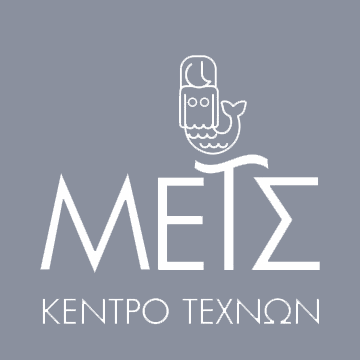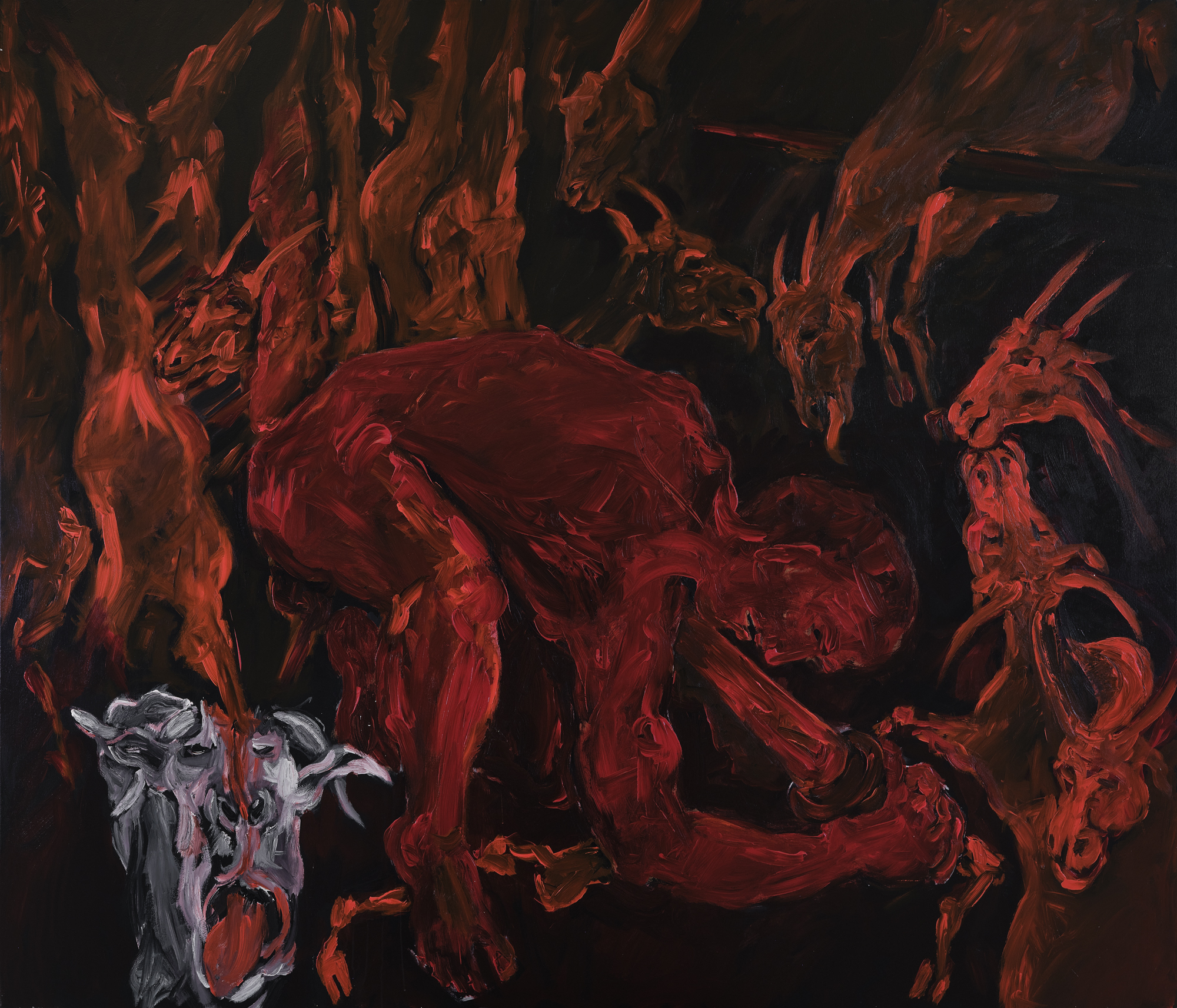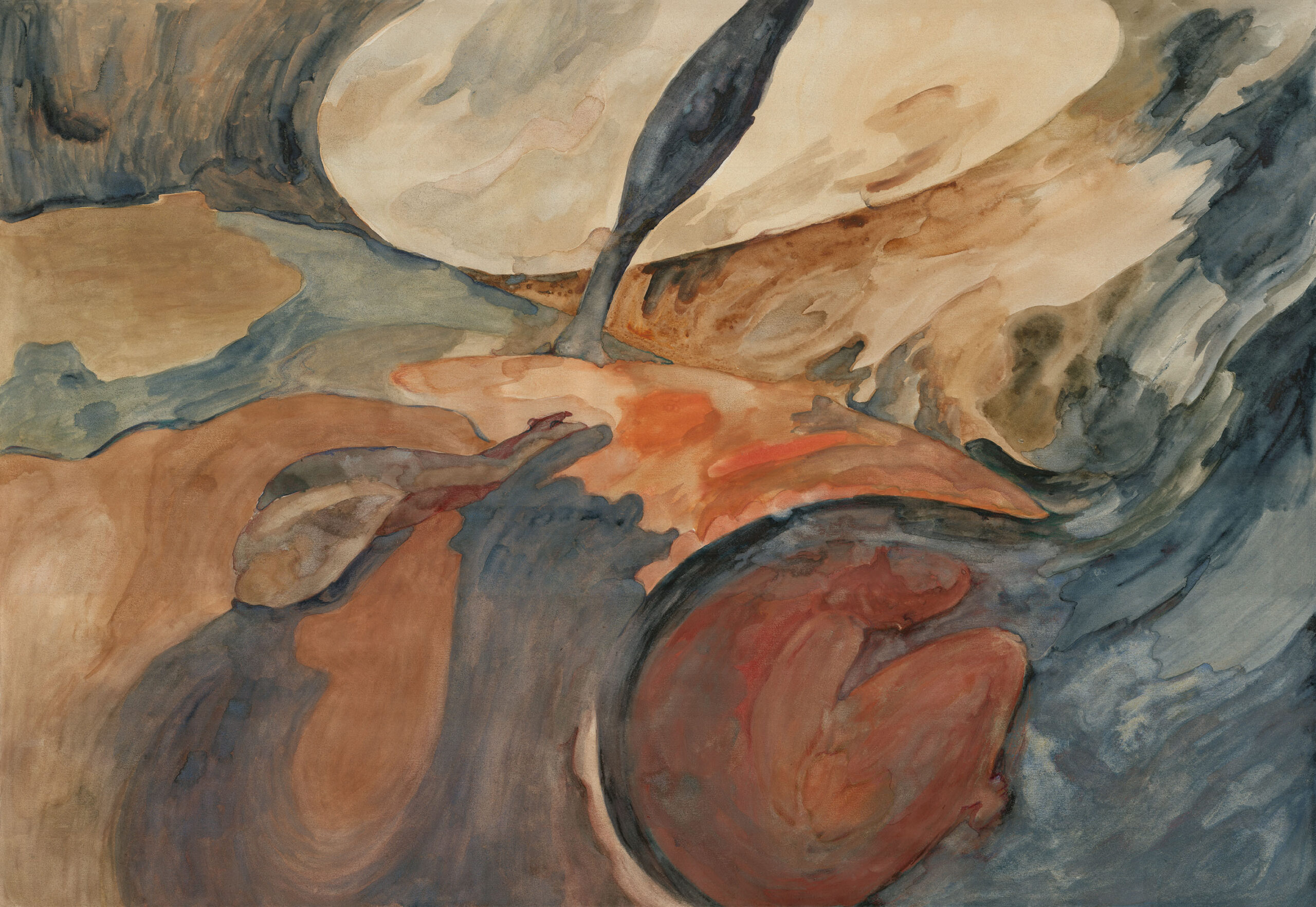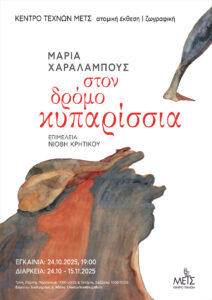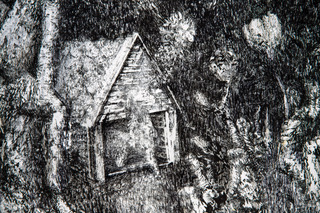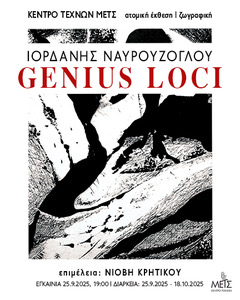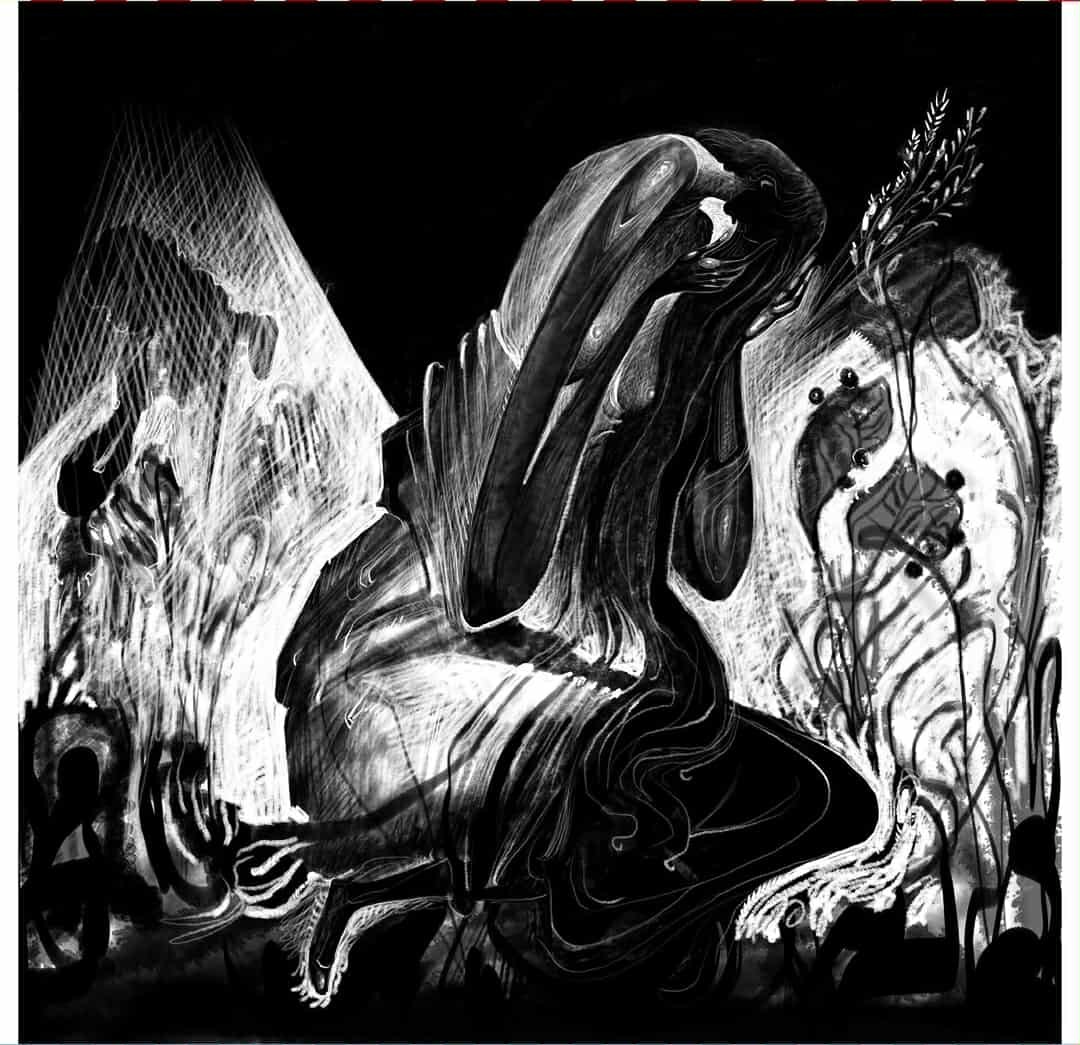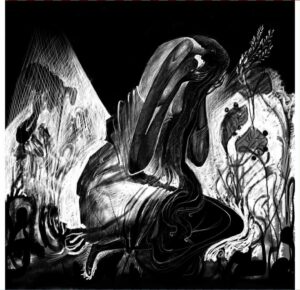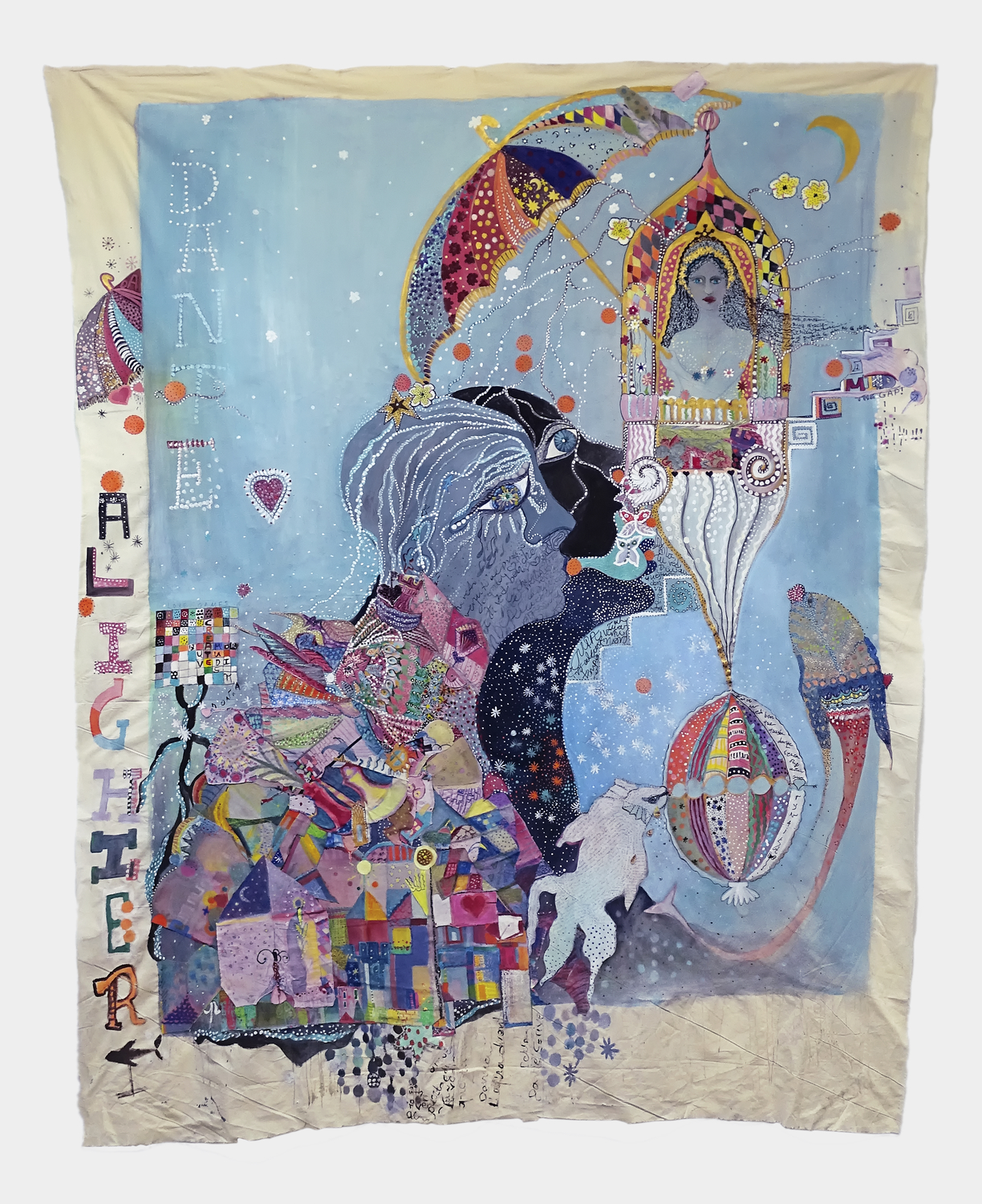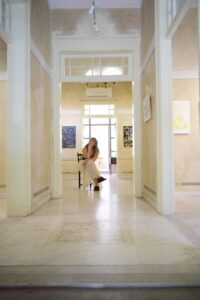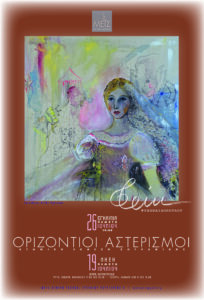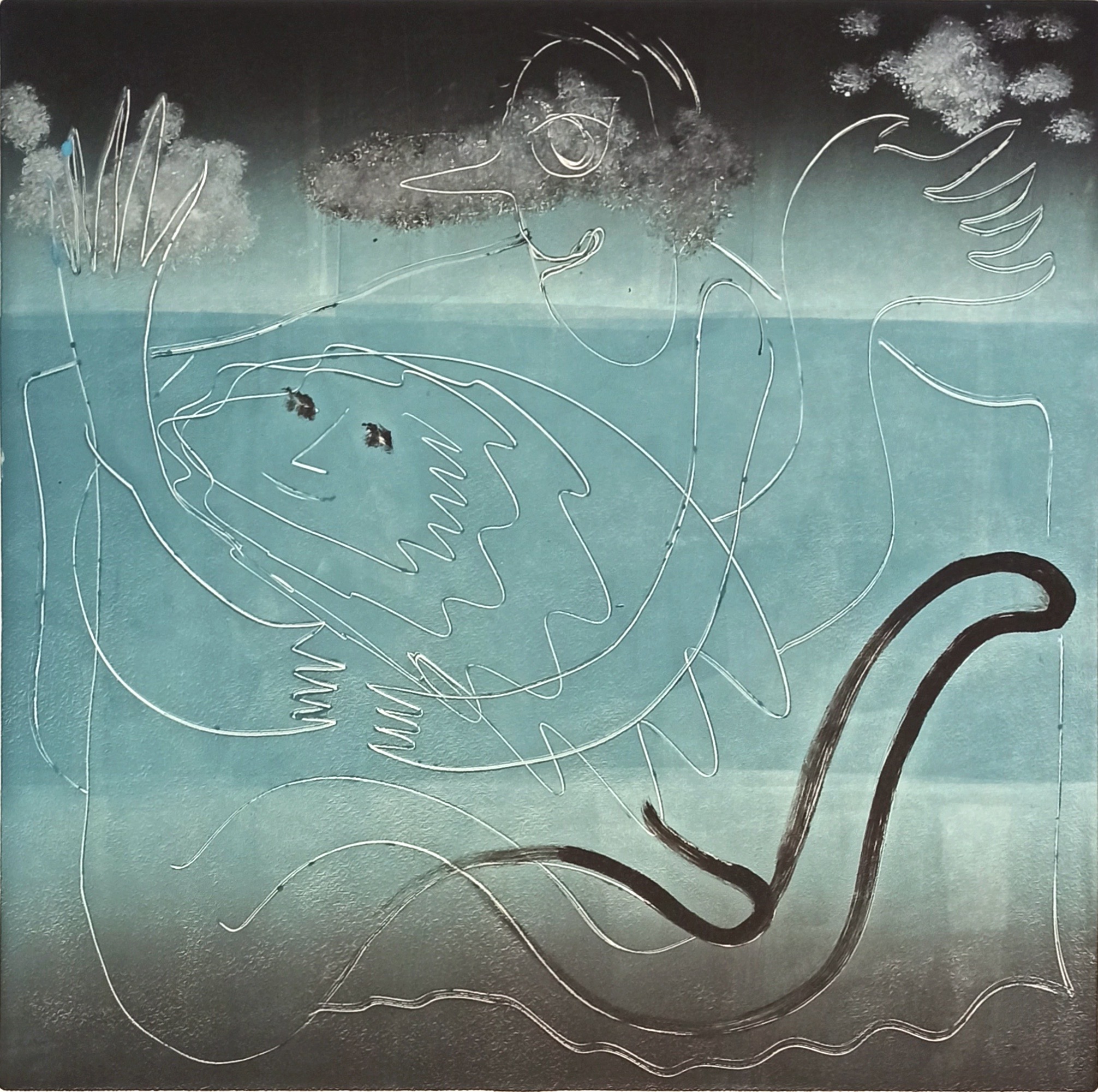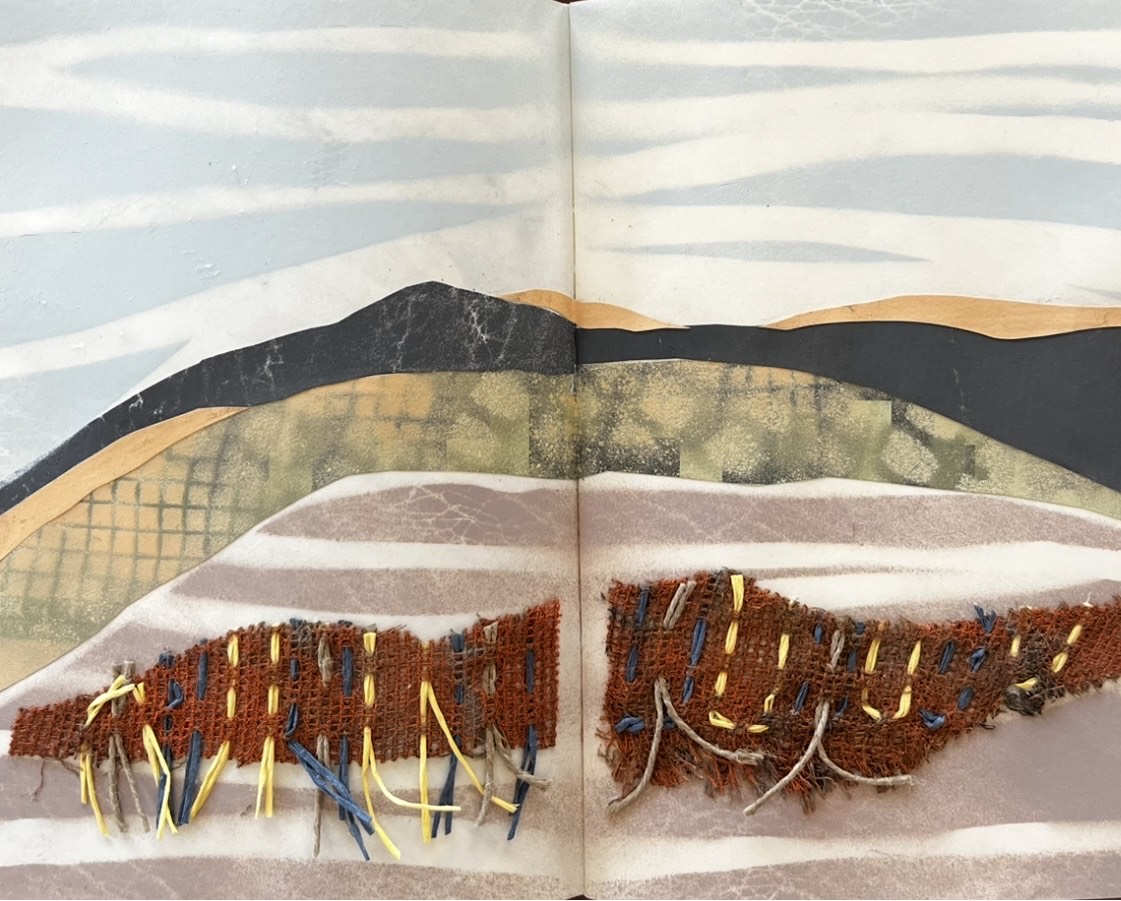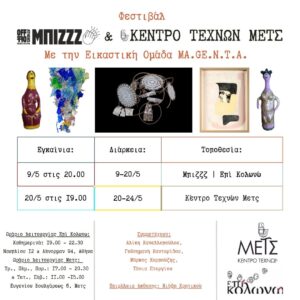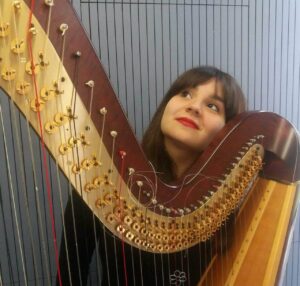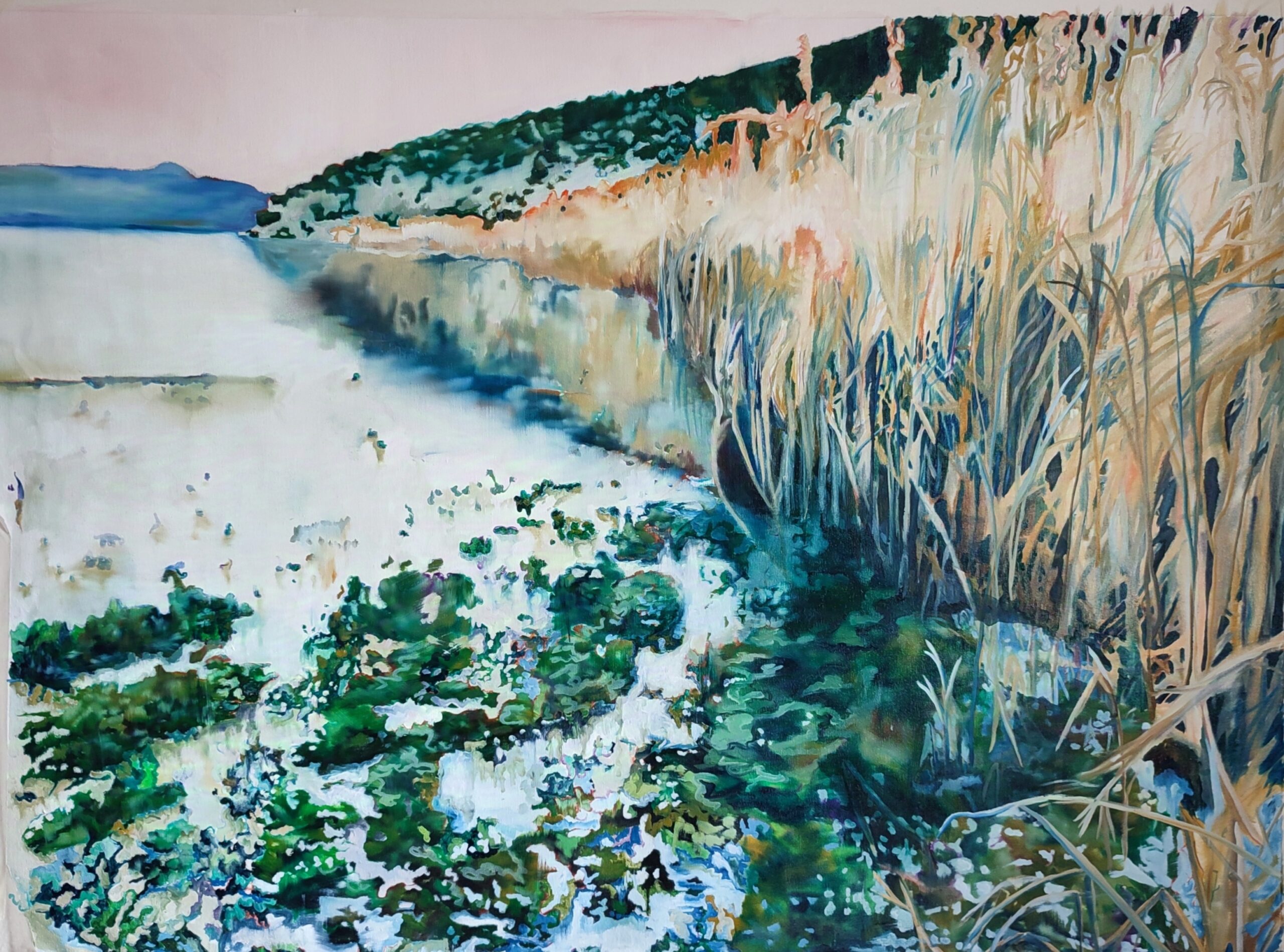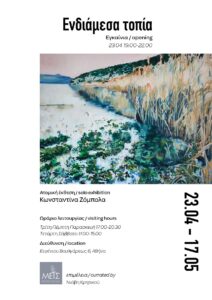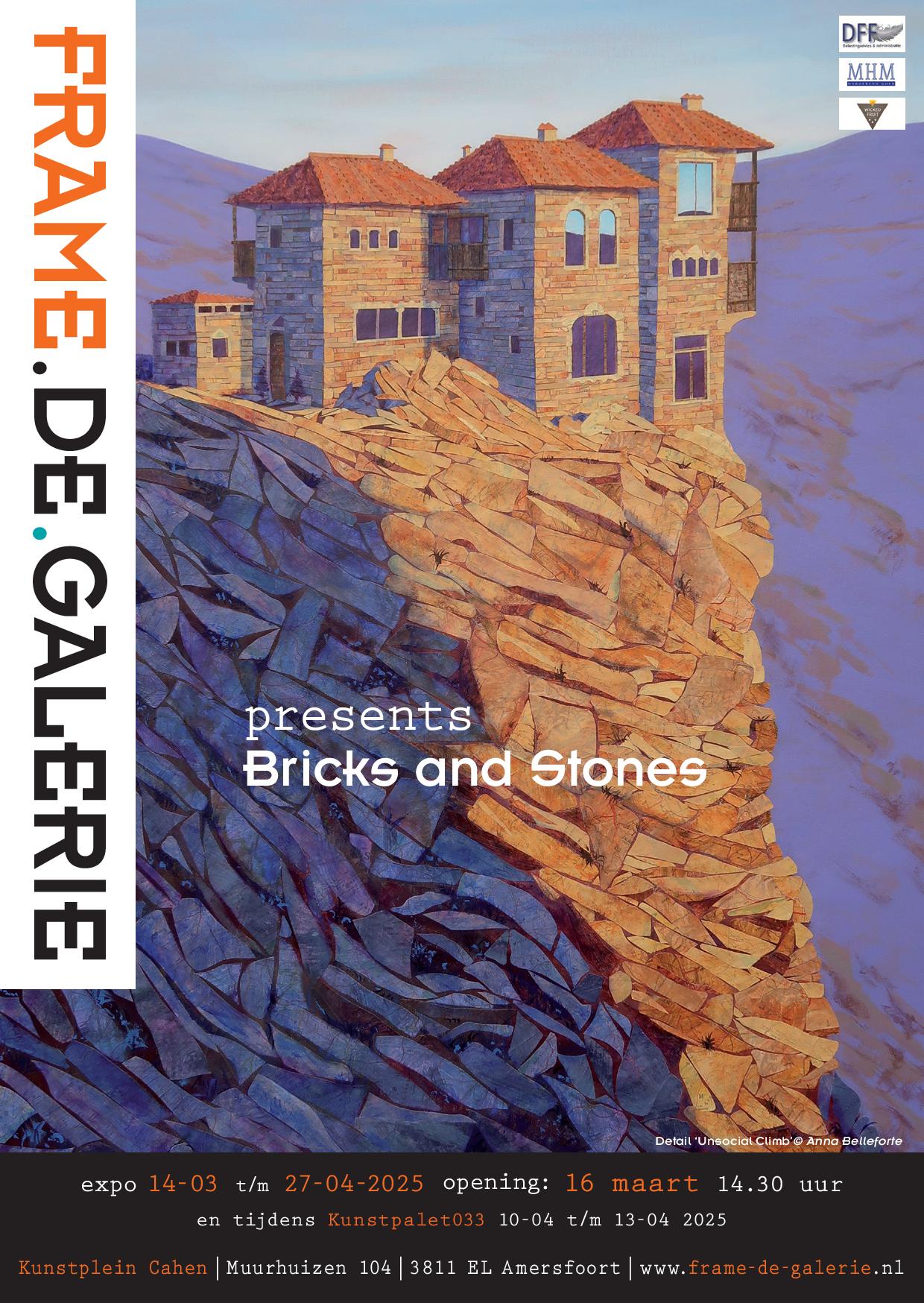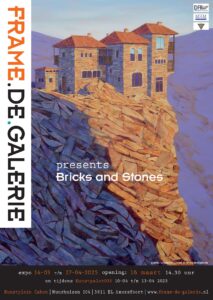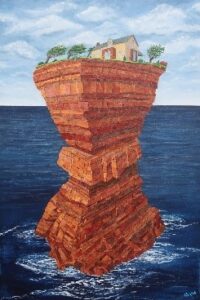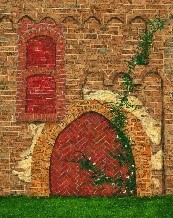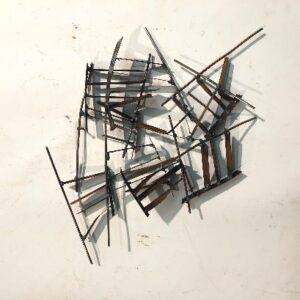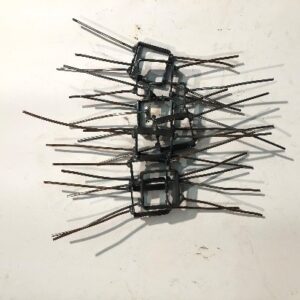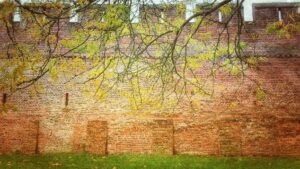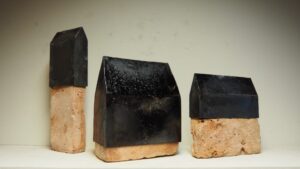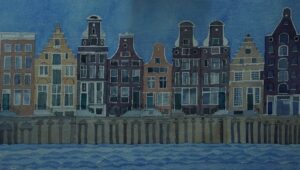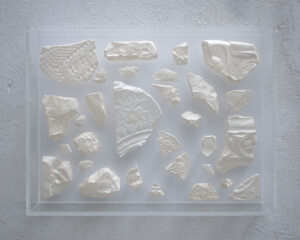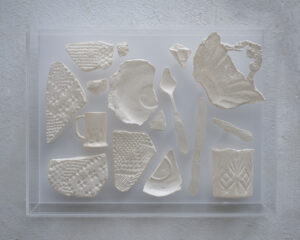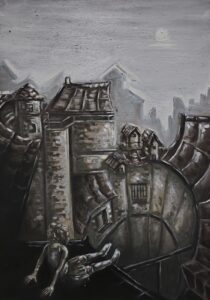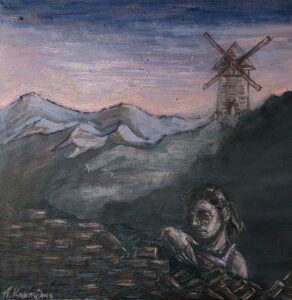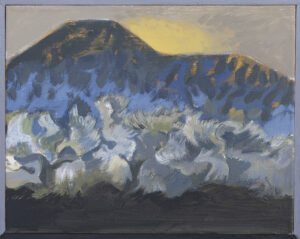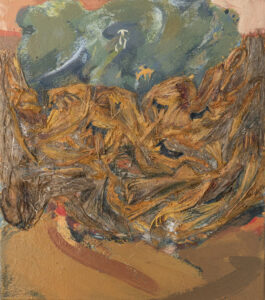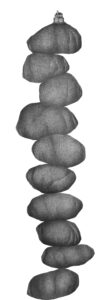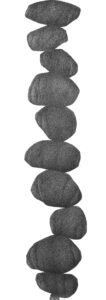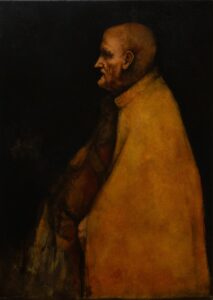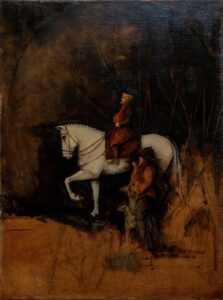Γιάννης Τζερμιάς
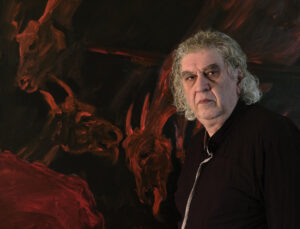


«Οιδίπους- Εικόνες μετά την τύφλωση, τριλογία 2008-2025» & «Το δαχτυλίδι στον βάλτο με τα νούφαρα»
Δύο εκθέσεις, δύο σταθμοί στην εικαστική πορεία του Γιάννη Τζερμιά συνθέτουν φέτος μια ενιαία αφήγηση γύρω από τη μοίρα, το μύθο και την ανθρώπινη ύπαρξη και δημιουργούν ένα σύγχρονο πολιτιστικό μονοπάτι ανάμεσα στο Θησείο και το Μετς, δύο ιστορικές γειτονιές της Αθήνας.
Η πρώτη έκθεση, με τίτλο «Οιδίπους- Εικόνες μετά την τύφλωση, τριλογία 2008 – 2025», παρουσιάζεται στο Πολιτιστικό Κέντρο Μελίνα Μερκούρη (Ηρακλειδών 66, Θησείο) και εγκαινιάζεται στις 06 Νοεμβρίου 2025 και ώρα 18.30 – 22.00. Στο επίκεντρο βρίσκεται ο Οιδίποδας, μια μορφή αρχέτυπο της ανθρώπινης τραγωδίας, την οποία ο καλλιτέχνης επανεγγράφει μέσα από μια εσωτερική, προσωπική μα και πανανθρώπινη οπτική. Στη ζωγραφική του Τζερμιά, το φως δεν σώζει αλλά καίει, το αίμα, η στάχτη και το χρυσό μετατρέπονται σε σύμβολα γνώσης και ύβρεως. Ο θεατής δεν παρακολουθεί την τραγωδία ως αναπαράσταση αλλά τη βιώνει ως εσωτερικό γεγονός, σε έναν κόσμο όπου η αλήθεια πληρώνεται με το ίδιο το φως των ματιών.
Δύο εβδομάδες αργότερα, το ταξίδι συνεχίζεται στο Κέντρο Τεχνών Μετς (Ευγενίου Βουλγαρέως 6) με την έκθεση «Το δαχτυλίδι στον βάλτο με τα νούφαρα» που εγκαινιάζεται στις 20 Νοεμβρίου στις 19.00-22.00, δύο εκθέσεις επιμελημένες από τη Νιόβη Κρητικού. Εδώ, ο μύθος υποχωρεί για να αναδυθεί το παραμύθι, εκεί όπου η παιδική μνήμη, η γιαγιά και ο βάλτος γίνονται τόποι μιας νέας εικονοποιίας. Ο βάλτος λειτουργεί ως μήτρα του ασυνείδητου, όπου τα πλάσματα της νύχτας, οι νάρκισσοι και τα είδωλα καθρεφτίζουν τις πιο σκοτεινές πτυχές της ανθρώπινης ψυχής. Το δαχτυλίδι, ως μυστικό αντικείμενο, μεταμορφώνεται σε σύμβολο του απόλυτου πόθου, της λύτρωσης και της αιώνιας αναζήτησης. Στην καρδιά της αφήγησης, το αυτοπορτρέτο του καλλιτέχνη, φέροντας το δαχτυλίδι, συμπυκνώνει τον κύκλο ζωής και τέχνης: ο Τζερμιάς γίνεται ο ίδιος ο ήρωας του μύθου του
Οι δύο εκθέσεις δημιουργούν ένα μονοπάτι σύνδεσης, από το τραγικό στο παραμυθητικό, από τον Οιδίποδα ως το δαχτυλίδι, από την τύφλωση στη γνώση και από τη μοίρα στην επιθυμία. Ένα ενιαίο εικαστικό σύμπαν, όπου το φως και το σκοτάδι, η ύλη και το πνεύμα, η μνήμη και η αποκάλυψη συνομιλούν αδιάκοπα. Δύο εμβληματικές εκθέσεις με στόχο να δημιουργήσουν ένα σύγχρονο και ζωτικό διάλογο που ταξιδεύει.
Έκθεση Ι
Τίτλος: Οιδίπους- Εικόνες μετά την τύφλωση, τριλογία 2008-2025 | Γιάννης Τζερμιάς
Χώρος: Πολιτιστικό Κέντρο Μελίνα Μερκούρη, Ηρακλειδών 66, Θησείο
Εγκαίνια: 06/11/2025 ώρα: 18.30 – 22.00
Διάρκεια: 06/11/2025 – 30/11/2025
Επιμέλεια: Nιόβη Κρητικού
Έκθεση ΙΙ
Τίτλος: Το δαχτυλίδι στον βάλτο με τα νούφαρα | Γιάννης Τζερμιάς
Επιμέλεια: Νιόβη Κρητικού
Χώρος: Κέντρο Τεχνών Μετς, Ευγενίου Βουλγαρέως 6
Εγκαίνια: 20/11/2025 [Δύο εβδομάδες μετά την πρώτη] ώρα: 19.00 – 22.00
Διάρκεια: 20/11/2025 – 13/12/2025
Επιμέλεια: Nιόβη Κρητικού
Γιάννης Τζερμιάς – Στο βάθος του τραγικού – «Οιδίπους, εικόνες μετά την τύφλωση»
Ο μύθος του Οιδίποδα και ο τρόπος που τον επανεγγράφει ο Γιάννης Τζερμιάς, αποτελεί έναν κομβικό σταθμό στην εικαστική έκφραση του ίδιου, εισάγοντας εδώ αλλά και στις προηγούμενες τραγωδίες που έχει ασχοληθεί (Αγαμέμνων, Μήδεια, Αίας, Φιλοκτήτης, Βάκχες), στοιχεία αυτοβιογραφικά. Δεν είναι απλώς μια σκιά από παρελθόντα χρόνο, αλλά μια ανοιχτή πληγή της ανθρώπινης μοίρας. Από το βρέφος που παραδίδεται στον βοσκό, δεμένο στα πόδια, ως τον τυφλωμένο βασιλιά που στέκει απέναντι στην αλήθεια του, η διαδρομή ξετυλίγεται σαν αργόσυρτη πομπή προς το αναπόφευκτο. Στις εικόνες του καλλιτέχνη, το αίμα και η στάχτη γίνονται χρώματα, το φως δεν σώζει αλλά καίει. Ο θεατής βλέπει την τραγωδία όχι σαν αναπαράσταση αλλά σαν μια εσωτερική εμπειρία που τον διαπερνά.
Μετά την αυτοτύφλωση, ο Τζερμιάς επανέρχεται για να ολοκληρώσει τον μύθο, χαρίζοντάς του μια μυσταγωγική διάσταση στον ήρωα. Το τοπίο μοιάζει να βυθίζεται σε πίσσα πυκνή και θερμή∙ μια ατμόσφαιρα ασφυκτική, όπου οι σκηνές του δρόμου, του φόνου, του αινίγματος, του έρωτα, της μαντείας και της τύφλωσης συνθέτουν την εισαγωγή της εικαστικής αφήγησης.
Ο βοσκός – βώτωρ, πρώτος μάρτυρας και φορέας του άγους, έχει σημαίνουσα θέση στην εικαστική του αποτύπωση καθώς δεν φέρει απλώς το βρέφος αλλά ολόκληρο το βάρος της αφήγησης. Με έμφαση σε αυτόν, εκτυλίσσονται τα παραμύθια του και παίρνουν μορφή σκοτεινών αλληγοριών: τα πόδια του κρεμασμένου Οιδίποδα, το πορτραίτο της αίγας Αμάλθειας με την σκωπτική ματιά της αποτελεί και την ειρωνεία της μοίρας που θρέφει και καταστρέφει. Έπειτα, σαν χορικό αρχαίας τραγωδίας, τα εκατόν πενήντα πορτρέτα των κατσικιών που σχηματίζουν μια πολυφωνία. Άλλοτε αθώα, άλλοτε ειρωνικά, παιχνιδιάρικά ή δαιμονικά, σκιαγραφώντας το ίδιο το πρόσωπο της ανθρωπότητας.
Στο τρίστρατο,
στη Σφίγγα και στην Ιοκάστη, οι μορφές σπαράζουν μέσα στην εικόνα σαν ύβρης που φλέγεται μπροστά μας. Η αλήθεια αποκαλύπτεται με το πορτραίτο της αυτοτύφλωσης όπου ο Τζερμιάς με χρυσό και ώχρα δημιουργεί μια καταιγίδα χρώματος με συναισθηματική φόρτιση του τραγικού. Η γνώση πληρώνεται με το ίδιο το φως των ματιών.
Η ζωγραφική του Τζερμιά είναι αμείλικτη, δωρική, πυρακτωμένη από την ίδια τη φύση του τραγικού. Στα χρώματα του αντηχούν τα λόγια του Καβάφη «σαν το άχρηστο φως που λάμπει, μα δεν σώζει». Μαύρο, λευκό, κόκκινο και ώχρα συγκρούονται σαν γροθιές, ενώ το χρυσό διασπά την αγριότητα σαν υπόσχεση υπέρβασης, σαν μια παραβολή καινής διαθήκης. Στις μορφές του καλλιτέχνη, ο άνθρωπος παλεύει με το ίδιο του το είναι, εκτίθεται γυμνός απέναντι στη μοίρα του. Το δέος έρχεται πρώτο, όχι μόνο στη φύση της τραγικότητας αλλά και στην αναπαράσταση της φόρμας του. Το μεγαλείο, η κλίμακα και η ατμόσφαιρα των έργων του εικαστικού θυμίζουν βουβές, ασφυκτικές δονήσεις, σαν τον υπόκωφο παλμό ενός κοντραμπάσου. Το πλάσιμο του θυμίζει διαδικασία σμίλευσης πηλού, που στριφογυρίζει ξανά και ξανά αφήνοντας αποτυπώματα της δράσης του μέχρις ότου να βρει την τελική του μορφή. Η αναζήτηση της εσωτερικής αλήθειας του πάνω στον καμβά είναι ένα τοπίο που κοχλάζει.
Μέσα λοιπόν, σε αυτό το πύρινο τοπίο του, ξεχωρίζουν και τα λόγια του:
«Οι ήρωες των τραγωδιών μιλούν σε κάθε μια πτυχή που κρύβει η ανθρώπινη ύπαρξη».
Ο Οιδίποδας γίνεται η ίδια η ανθρώπινη συνθήκη: άνθρωπος που βλέπει μόνο όταν τυφλωθεί, που σώζεται και καταστρέφεται συγχρόνως. Το έργο του Τζερμιά αποκαλύπτει τη διπλή αλήθεια, ότι το τραγικό δεν είναι ιδέα αφηρημένη αλλά θεμέλιο της ύπαρξής μας. Η ζωγραφική του μεταμορφώνεται σε οιδιπόδεια τελετουργία και ο ίδιος σε σύγχρονο πλανευτή ιδεών, σαν την ίδια την ιδέα του «Παίχτη»∙ σκηνοθετεί το αφήγημα όπου οι μύθοι αναγεννιούνται και η ανθρώπινη ύπαρξη στέκει γυμνή απέναντι στη μοίρα της. Στο βάθος του τραγικού, ο Τζερμιάς αποκαλύπτει το αναπόδραστο δίπολο που κατοικεί σε κάθε ψυχή.
Νιόβη Κρητικού
Yiannis Tzermias – In the Depth of the Tragic – Oedipus, Images After the Blinding
The myth of Oedipus, as reimagined by Yiannis Tzermias, is a turning point in his art. Here, as in the earlier tragedies he has embraced (Agamemnon, Medea, Ajax, Philoctetes, Bacchae) the personal becomes mythic, and myth becomes autobiography. It is not a shadow from another time. It is an open wound of human fate. From the infant delivered to the shepherd, feet bound, to the blinded king who stands before his own truth, the path unfolds like a slow procession toward what cannot be escaped. In his images, blood and ash are turned to color. Light does not redeem. It burns. The viewer does not witness tragedy. They undergo it.
After the blinding, Tzermias returns to seal the myth, to endow the hero with mystagogy. The landscape sinks into dense pitch, heavy, suffocating. Road, murder, riddle, love, prophecy, blindness, they converge as prologue to his visual chant. And at the center, the shepherd. The first witness, bearer of the curse. He carries not only the infant, but the weight of the whole story. From him, the artist’s dark allegories unfold: the feet of the hanged Oedipus. The portrait of Amalthea, the goat with the sardonic gaze, the irony of a fate that both nourishes and destroys. And then, like the chorus of an ancient play, one hundred and fifty portraits of goats. Innocent, mocking, playful, demonic. A polyphony that sketches the very face of humanity.
At the crossroads.
At the Sphinx. At Jocasta. Figures convulse, as if hybris itself were burning before us. The truth is revealed in the portrait of self-blinding, where gold and ochre ignite a storm, the canvas charged with the weight of the tragic. Knowledge is paid for with the very light of the eyes. Tzermias’ painting is relentless. Doric. Incandescent with the fire of the tragic. In his palette echo Cavafy’s words: “like the useless light that shines, yet does not save.” Black, white, red, ochre — clashing like fists. Gold breaking through savagery, a promise of transcendence, a parable of a new testament. In his figures, man wrestles with his own being, naked before destiny. Awe comes first. Not only in the nature of the tragic. But in the very form of its representation. The grandeur. The scale. The atmosphere. They recall the mute, suffocating vibrations of a double bass rising from the depths. His shaping is like clay in ceaseless motion, turned and pressed, until the final form is revealed. His search for inner truth becomes a landscape that seethes and boils.
And within this fiery landscape, his words echo:
“The heroes of tragedies speak to every hidden fold of human existence.”
Oedipus becomes the human condition itself. A man who sees only when blinded. Who is saved and destroyed at once. In Tzermias’ work the double truth is revealed: the tragic is not an abstract idea. It is the very foundation of our existence. His painting becomes Oedipal ritual. He himself, a conjurer of ideas, a player of myths reborn, where human existence stands stripped before its fate. In the depth of the tragic, Tzermias discloses the unyielding duality that dwells within every soul.
Niovi Kritikou
Γιάννης Τζερμιάς – Το δαχτυλίδι στο βάλτο με τα νούφαρα
Ένα παραμύθι που του ψιθύριζε η γιαγιά του, γίνεται για τον Γιάννη Τζερμιά η αρχή μιας νέας εικονοποιίας. Ο βάλτος, ως κεντρικός τόπος, δεν είναι απλώς σκηνικό∙ λειτουργεί σαν αρχαιολογικός χώρος, σαν άχρονη μήτρα όπου βυθίζονται μνήμες και μορφές. Από τα πυκνά νερά του αναδύονται νυκτόβια πλάσματα, μυθικά πρόσωπα και νάρκισσοι που καταπίνουν την ύπαρξη, πνίγοντας κάθε προσπάθεια διαφυγής. Από τη Νεάπολη ως τον Δρηδό, οι προσωπικές μνήμες του ζωγράφου αναπαριστούν τις μυστικές, παραμυθητικές αναφορές που πυκνώνουν τη σκηνοθεσία του. Σαν εκκίνηση αυτής της αφήγησης στέκει το πορτραίτο της γιαγιάς με το μαντίλι ανεμίζον∙ προάγγελος του αφηγητή, θεματοφύλακας του μύθου που τώρα ξαναγεννιέται στη ζωγραφική. Το βλέμμα της προμηνύει μια κρυφή μα γεμάτη μυστήρια, διαδρομή.
Τα έργα του ξεδιπλώνουν όλες τις εκφάνσεις της ασπρόμαυρης κλίμακας. Με πηχτές πινελιές, δραματικά κοντράστα, μια ατμόσφαιρα film noir ο ίδιος καταπνίγει το φως και δημιουργεί μια εσωτερική αγωνία. Ελάχιστα επαναστατικά καθαρά χρώματα, με κύριο πρωταγωνιστή το κίτρινο αλλά και πινελιές κόκκινου εμφανίζονται δειλά στα έργα σαν εκλάμψεις πάνω στον καμβά, ψήγματα αλήθειας. Σαν ξαφνικές ιδέες που καίνε πριν σβήσουν ξανά στη νύχτα. Το φως στο έργο του δραμματικό, δεν σώζει, αλλά σηματοδοτεί την αγωνία, τη διεκδίκηση, την πορεία προς έναν απώτερο εσωτερικό στόχο. Το παραμύθι εδώ γίνεται μια σύγχρονη παραβολή με κεντρικό στοιχείο ενδιαφέροντος το πολυπόθητο κρυμμένο στο βάλτο, δαχτυλίδι. Το κλειδί της διεκδίκησης της πολυπόθητης πριγκίπισσας. Είναι το μυστικό αντικείμενο της αναζήτησης και συνάμα το κλειδί της λύτρωσης που κρύβεται στα θολά νερά αλλά και στις απόκρυφες πτυχές του εαυτού μας.
Όπως και στη μουσική του Mahler,
3η και 5η συμφωνία, η αφήγηση του Τζερμιά κορυφώνεται και καταρρέει, σαν μια συμφωνία με απόλυτη λύση. Με κεντρικό έργο της ενότητας να αποτελεί το αυτοπορτρέτο του καλλιτέχνη που φέρει το δαχτυλίδι. Ο Τζερμιάς γίνεται ο ίδιος ο ήρωας και εισάγει μέσα στο έργο του πλήθος αυτοβιογραφικών αναφορών. Σε κοντραπόστο στάση, ο ίδιος παρουσιάζεται δραματικός, φέροντας τη σκιά της τραγωδίας που συνοδεύει κάθε του έργο. Η ατμόσφαιρα του γοτθική, μεσαιωνική, μα συνάμμα και ρομαντική, με την αυτοκαταστροφική όμως έννοια του ρομαντικού ήρωα, με τους πλατωνικούς του πόθους και το αιώνια ανεκπλήρωτο αίτημα.
Ο βάλτος ενυπάρχει σε όλα τα έργα σαν πέπλο και κυκλώνει το κάστρο, που ωστόσο μονάχα υπονοείται. Ένας χώρος απαγορευμένος, μαντικός, που εμφανίζεται μονάχα στο νου του θεατή, γίνεται πεδίο εσωτερικής διερεύνησης. Η εικόνα αυτή απλώνεται εκφραστικά καλύπτοντας με υγρασία, καταχνιά και ομίχλη το τοπίο. Οι ήρωες του αναζητητές αλήθειας χάνονται μέσα στο κόντρα φως. Το πλάσιμο της γραφής του αναμετριέται με την φόρμα, την αψηφάει για να την ξανασυναντήσει στιβαρή. Οι φιγούρες του παραμορφώνονται, φλέγονται μέσα στο λευκό εκτυφλωτικό φως και έπειτα χάνονται στα βάθη του μαύρου. Και όμως, κάτω από την αγωνία, κρύβεται μια υπόσχεση. Ο Απόλυτος Πόθος: η ευτυχία, η ολοκλήρωση.
Οι μορφές αναδύονται σαν πρωτόπλαστοι μέσα από τη γη, σχεδόν χωμάτινοι, λερωμένοι με την ιερή λάσπη, την ίδια την ουσία της ύπαρξή. Ο χρόνος στο έργο δεν παρουσιάζεται γραμμικά, δεν κυλά∙ αλλά εμφανίζεται σε θραύσματα, σαν σεκάνς κινηματογραφική. Ο θεατής με τη σειρά του μετατρέπεται κι αυτός σε έναν διεκδικητή του δαχτυλιδιού. Το κυνήγι του θησαυρού γίνεται προσωπικό μυστήριο του καθενός. Μια πρόσκληση προς συμμετοχή στην εξιχνίαση. Του εαυτού; Του στόχου; Του πόθου ή του ατέρμονου κύκλου της εκπλήρωσης; Σε κάθε ανάγνωση το έργο του σκιαγραφεί την έννοια της Τελικότητας και του σκοπού.
Ανατρέχοντας στα λόγια του Novalis «εκεί όπου είμαστε, βρίσκεται και το μυστήριο», συναντώ λοιπόν τον βάλτο του Τζερμιά. Είναι ο καθρέφτης αυτού του μυστηρίου. Τόπος σκιών, επιθυμίας και λύτρωσης. Και το αίνιγμα μένει ανοιχτό στον θεατή: είναι αρχή ή τέλος; Ποιος κρατά το δαχτυλίδι στο χέρι του;
Νιόβη Κρητικού
Yiannis Tzermias – The Ring in the Marsh of Water Lilies
A fairy tale whispered to him by his grandmother becomes, for Yiannis Tzermias, the beginning of a new imagery. The swamp, as a central site, is not merely a backdrop. It acts as an archaeological ground, a timeless womb where memories and figures sink. From its dense waters emerge nocturnal creatures, mythical faces, and water lilies that swallow existence, drowning every attempt at escape. From Neapoli to Dridos, the painter’s personal memories give form to hidden, tale-like references that thicken the stage of his vision. At the threshold of this narration stands the portrait of the grandmother with her scarf fluttering, a harbinger of the storyteller, guardian of the myth now reborn through painting. Her gaze foreshadows a secret path, full of mystery.
His works unfold every nuance of the black-and-white scale. With thick brushstrokes, dramatic contrasts, an atmosphere steeped in film noir, he suffocates the light and creates an inner tension. Pure, revolutionary colors, yellow in particular and some red strokes, appear as sudden flashes on the canvas, fragments of truth, fleeting ideas that burn before vanishing again into night. Light, in his works, is dramatic. It does not save but marks anguish, struggle, the pursuit of a distant inner goal. The fairy tale becomes here a contemporary parable, with the hidden ring at the center. The key for the princess. Desired, buried in the swamp, it is both the secret object of the quest and the key to redemption, lying within murky waters and within the concealed depths of the self.
As in Mahler’s 3rd and 5th symphonies,
Tzermias’ narration rises and collapses, reaching resolution in an almost absolute cadence. The central piece of the cycle is the artist’s self-portrait holding the ring. Tzermias becomes the hero himself, weaving into the work a multitude of autobiographical threads. In contrapposto, he appears dramatic, marked by the shadow of tragedy that accompanies all his works. His atmosphere is gothic, medieval, yet at once romantic, in the sense of the self-destructive romantic hero, with Platonic longings and the eternally unfulfilled demand.
The swamp exists in every work like a veil, encircling the castle that is only ever implied. A forbidden, prophetic realm that emerges only in the viewer’s imagination becomes a field of inner excavation. This image spreads across the canvas, laden with humidity, fog, and mist, cloaking the landscape. His seekers of truth are lost in the counterlight. His brushwork wrestles with form, resists it, and then returns to it, solid and unyielding. Figures distort, burn in blinding white light, then vanish into the depths of black. And yet, beneath the anguish lies a promise: the Absolute Desire, happiness, completion. His figures rise like the first-born out of the earth, soil-bound, marked by sacred mud, by the very substance of existence. Time does not flow linearly in his work. It breaks into fragments, like cinematic sequences. The viewer, in turn, becomes a claimant to the ring. The treasure hunt transforms into each one’s personal mystery, a call to participation in the deciphering. Of the self? Of the goal? Of desire, or of the endless circle of fulfillment? In every reading, his work sketches the notion of finality, of purpose.
Recalling the words of Novalis, “where we are, there is the mystery,” I encounter Tzermias’ swamp. It is the mirror of that mystery. A place of shadows, of longing, of redemption. And the riddle remains open to the viewer: is it a beginning or an end? Who is it that holds the ring?
Niovi Kritikou
ΒΙΟΓΡΑΦΙΚΟ
Γιάννης Τζερμιας
Γεννήθηκε στο Ηράκλειο Κρήτης το 1954. Μεγάλωσε στη Νεάπολη Κρήτης. Το 1968 εγκαταστάθηκε στην Αθήνα. Σπούδασε γραφικές τέχνες στη Σχολή Βακαλό (1973-1977). Στη ζωγραφική είχε δασκάλους τους Κ. Σπίθα, Γ. Βαλαβανίδη, Π. Τέτση και Β. Δημητρέα. Ιδιαίτερη σημασία για το έργο του Γιάννη Τζερμιά αποτέλεσε η διδασκαλία της Ελένης Βακαλό. Πραγματοποίησε την πρώτη του ατομική έκθεση στην Αίθουσα Τέχνης Μέδουσα το 1985, όπου παρουσίασε ασπρόμαυρα σχέδια με μελάνι και μεγάλες συνθέσεις μεικτής τεχνικής με εξπρεσιονιστική διάθεση. Στην επόμενη ενότητα Μαγικό Τοπίο (Αίθουσα Τέχνης Μέδουσα, 1988) αποτυπώνει τοπία από το φυσικό περιβάλλον, αντανάκλαση του εσωτερικού του κόσμου. Στην ενότητα Περί Φύσεως (Αίθουσα Τέχνης Μέδουσα, 1995) εμπνέεται από το ομότιτλο κείμενο του Εμπεδοκλή και το έργο του αποκτά εννοιολογική διάσταση με εξπρεσιονιστική γραφή Στις Σταυρώσεις (Μικρό Βιβλιοπωλείο των Εκδόσεων Γαβριηλίδη, 1999), πραγματεύεται το υπαρξιακό πρόβλημα της Σταύρωσης, μέσα από πολλαπλές παραλλαγές, σχεδιαστικές και χρωματικές. Η επόμενη ενότητα Κ(Χ)ρόνος (Αίθουσα Τέχνης Μέδουσα, 2001) παραπέμπει στους ήρωες τεσσάρων αρχαίων τραγωδιών (Αίας, Φιλοκτήτης, Μήδεια, Αγαμέμνων), με πίνακες μικρών και μεγάλων διαστάσεων, σχέδια και βιβλία.Με την έκθεση Οιδίπους: Εικόνες μετά την τύφλωση (Αίθουσα Τέχνης Μέδουσα, 2011) και Βάκχες 2018-ΒΚΧΣ, συμπληρώνει τον κύκλο των τραγικών ηρώων. Στα έργα του κυριαρχεί η συμβολική διατύπωση της αιώνιας πάλης ανάμεσα στο φως και το σκότος. Η τεχνοτροπία του κινείται στο μεταίχμιο μεταξύ του εξπρεσιονισμού και της νέας παραστατικότητας. Ασχολήθηκε επίσης με την υαλοτυπία, συνεργαζόμενος με τον φωτογράφο Ν. Μάρκου. Το1991 εξέδωσε, με την Αίθουσα Τέχνης Μέδουσα, το λεύκωμα «Οι Άθλοι του Ηρακλή» και το 2001 το λεύκωμα «Κ(Χ)ρόνος». Έχει πραγματοποιήσει ατομικές εκθέσεις στην Αθήνα και την Θεσσαλονίκη, ενώ έχει λάβει μέρος σε δεκάδες ομαδικές εκθέσεις στην Ελλάδα και το εξωτερικό.
EN
Giannis Tzermias
He was born in Heraklion, Crete, in 1954 and grew up in Neapoli, Crete. In 1968, he moved to Athens. He studied graphic arts at the Vakalo School (1973–1977). In painting, his teachers included K. Spitha, G. Valavanidis, P. Tetsis, and V. Dimitreas. The teaching of Eleni Vakalo had a particularly significant influence on his work.
He held his first solo exhibition at the Medusa Art Gallery in 1985, presenting black-and-white ink drawings and large mixed-media compositions with an expressionist mood. In the next series, Magic Landscape (Medusa Art Gallery, 1988), he captured landscapes from the natural environment, reflecting his inner world. In On Nature (Medusa Art Gallery, 1995), inspired by the homonymous text by Empedocles, his work took on a conceptual dimension with an expressionist style.
In Crucifixions (Small Bookstore of Gavriilidis Editions, 1999), he explored the existential problem of the Crucifixion through multiple variations in both drawing and color. The following series, K(X)ronos (Medusa Art Gallery, 2001), refers to the heroes of four ancient tragedies (Ajax, Philoctetes, Medea, Agamemnon), featuring paintings of various sizes, drawings, and books. With the exhibitions Oedipus: Images After Blindness (Medusa Art Gallery, 2011) and Bacchae 2018–BKHS, he completed the cycle of tragic heroes.
In his works, the symbolic expression of the eternal struggle between light and darkness predominates. His technique lies at the intersection between expressionism and the new figuration. He has also worked with glass printing, collaborating with photographer N. Markou. In 1991, he published the album The Labors of Heracles with Medusa Art Gallery, followed by K(X)ronos in 2001. He has held solo exhibitions in Athens and Thessaloniki and has participated in numerous group exhibitions in Greece and abroad.
